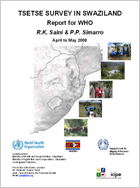Tsetse fly survey in Eswatini, April to May 2008

Overview
A tsetse survey in Eswatini was undertaken in order to establish the true picture of trypanosomiasis in the country for it to be declared a Tsetse and Trypanosomiasis free zone, in view of the fact that no Human African Trypanosomiasis (HAT) cases have been reported for more than a century and only two African Animal Tryapanosomiasis cases have been reported in the last two decades (but even in these cases the animals came across the border). Based on historical fly distribution data, an area of approximately 7,475 km2 was originally demarcated for the survey. This area was divided into 75 grids (each 10 x 10 km). The actual area was further reduced to approximately 3,525 km2 on the basis of satellite images observed for each grid and field reconnaissance prior to deployment of traps. 372 H-traps were deployed in this area covering an area of approximately 3,000 km2. The survey area extended from Lavumisa in the South to Lomahasha in the North and the Northern part of Swaziland where Mbuluzi River starts right up to the area it enters Mozambique. This area falls in Hhohho, Lubombo and Shishelweni districts and a greater part of it falls in the lowveld area to the East, which borders Mozambique and South Africa. Glossina austeni in very low densities were found in Mlawula Park close to the Mozambique border. Even though the tsetse fly densities were very low this has implications for the creation of tsetse free zones in South Africa and in Southern part of Mozambique, as this area could be a site for reinvasion. Trap catches included >5,000 Stomoxys, >300 Tabanid flies and >2,000 other insects.
Prior to the survey exercise a brochure for community sensitization was prepared and translated into siSwati (local language). Nearly 4,500 copies of this brochure were distributed in the survey area to Farming Communities, Cattle Ranches, Royal Swazi Police, Royal Defense Army and Game Parks in order to sensitize the communities for the smooth operation of the survey exercise.
Capacity building was an integral part of the exercise and twenty National participants have been trained in basic tsetse survey methodologies and 7 participants who were derived from the relevant Ministries have got hands-on training in trap deployment, maintenance and data collection.
In view of the fact that the G. austeni is not involved in the transmission of HAT and no cases have been reported for nearly a century the labeling of Swaziland as an HAT endemic country is questionable. A second seasonal survey that should include a parasitological assessment is recommended to confirm the distribution of tsetse and determine the trypanosomes involved. The survey team and the stakeholders involved have made several other recommendations, which are highlighted, in the main report.
